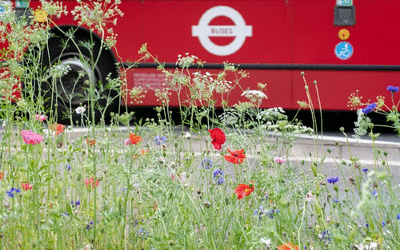Adapting to climate change

Climate Change Adaptation Plan
Our Climate Change Adaptation Plan is a strategic approach for managing our climate risks.
Adaptation can include a wide range of different actions to protect people from climate risk - from rain gardens to cooling systems.
The plan aims to ensure we can provide:
- Efficient and reliable walking, cycling and public transport services
- An outstanding customer experience
- An accessible, affordable and financially sustainable network
It builds on the Mayor's Transport Strategy and our Corporate Environment Plan.
Flooding, storms and heatwaves across the capital in recent years have caused safety incidents, damage to Londoners' health, widespread disruption and delays to our network, as well as financial challenges.
Climate change means that these kind of severe weather events are becoming more frequent and more intense. This will:
- Affect the safety and wellbeing of our staff and customers
- Affect the reliability and frequency of services
- Increase our operational costs
What are we already doing?
We've historically been able to recover quickly from severe weather events like floods and heatwaves - this is known as resilience.
As climate change increases however, the intensity and frequency of extreme weather events will also increase.
We need to adapt our transport system to stay resilient create a more attractive, nature-rich, liveable city with stronger communities.
July heat causes service closures and delays:
- Customers and staff taken ill
- Speed restrictions on Tube and rail
- £8m loss of revenue
- Construction work suspended
- Points, signalling and track circuit failures
Resilience
We have a consistent and structured approach to the management of extreme weather events. This involves using forecasting tools, risk assessments and adverse weather plans.
To give our customers the best service we work collaboratively with a range of stakeholders to:
- Manage risks
- Update operational procedures
- Tell customers about changes during weather disruption
- Repair damage quickly after extreme weather events
Our guide to sustainable drainage systems (SuDS) in London is on the Streets toolkit page.
Improving our understanding of climate risk
We're continually improving our understanding of climate risk through our Adaptation Reporting Power, Task Force on Climate-related Financial Disclosures (TFCD) reporting and our research programme.
Adaptation Reporting Power
We regularly submit a report to the Department for Environment, Food and Rural Affairs under the voluntary Adaptation Reporting Power, including a comprehensive Asset Climate Risk Assessment.
This report sets out how we manage climate risk governance, strategy and assessment. It focuses on the main climate risks facing London including precipitation, temperatures and storm and wind events.
Our most recent report (March 2022) includes our most detailed assessment yet of the current and future predicted effects of climate change on our infrastructure, colleagues and customers.
The climate risk assessment results were used as a baseline for our adaptation plan. It sets out how we are managing, and will continue to reduce, climate risks to people and our infrastructure.
Task Force on Climate-related Financial Disclosures (TCFD)
The TCFD is a framework which can be used by companies to report how climate change will affect their business. This includes both physical (impacts from climate change) and transitional risks (transition to net zero).
We made our first disclosure in our 2021/22 Annual Report. This included high-level qualitative information regarding our physical climate risks, as well as the risks and opportunities of transitioning to a low- carbon world.
Research programme
We have a dedicated research programme to better understand how severe weather and climate change affect us. The research programme started in 2018 in response to the Mayor's Transport Strategy's commitments on climate change adaptation and resilience.
Most of our research projects are collaborations with other organisations, such as universities. The nature of these projects means that results can take several years to become available. Examples of our published research include:
- London's Strategic SuDs pilot study - piloting, modelling and monitoring the benefits of SuDS
- The impact of heat on London Underground delays
- Improving estimation of future rates of deterioration that might lead to failure in transport infrastructure slopes - from the ACHILLES research consortium
Other projects are related to adaptation but are not a part of the dedicated research programme. For example, we are developing a natural capital account and exploring how to embed natural capital accounting into decision-making and relevant processes.
- Find out more about SuDs and natural capital account on the green infrastructure & biodiversity page
Future research
We're constantly improving our research and evidence base to better understand climate risks and how to manage them.

